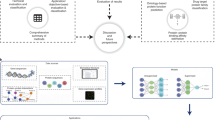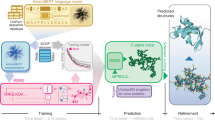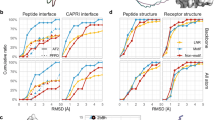Abstract
Protein-peptide interactions (PpIs) play a critical role in major cellular processes. Recently, a number of machine learning (ML)-based methods have been developed to predict PpIs, but most of them rely heavily on sequence data, limiting their ability to capture the generalized molecular interactions in three-dimensional (3D) space, which is crucial for understanding protein-peptide binding mechanisms and advancing peptide therapeutics. Protein-peptide docking approaches provide a feasible way to generate the 3D models of PpIs, but they often suffer from low-precision scoring functions (SFs). To address this, we developed DeepPpIScore, a novel SF for PpIs that employs unsupervised geometric deep learning coupled with a physics-inspired statistical potential. Trained solely on curated experimental structures without binding affinity data or classification labels, DeepPpIScore exhibits broad generalization across multiple tasks. Our comprehensive evaluations in bound and unbound peptide bioactive conformation prediction, binding affinity prediction, and binding pair identification reveal that DeepPpIScore outperforms or matches state-of-the-art baselines, including popular protein-protein SFs, ML-based methods, and AlphaFold-Multimer 2.3 (AF-M 2.3). Notably, DeepPpIScore achieves superior results in peptide binding mode prediction compared to AF-M 2.3. More importantly, DeepPpIScore offers interpretability in terms of hotspot preferences at protein interfaces, physics-informed noncovalent interactions, and protein-peptide binding energies.

This is a preview of subscription content, access via your institution
Access options
Subscribe to this journal
Receive 12 print issues and online access
$259.00 per year
only $21.58 per issue
Buy this article
- Purchase on SpringerLink
- Instant access to full article PDF
Prices may be subject to local taxes which are calculated during checkout







Similar content being viewed by others
Data availability
The source data and main scripts that implement the computational protocol are available at https://github.com/zjujdj/DeepPpIScore.
Code availability
The source data and main scripts that implement the computational protocol are available at https://github.com/zjujdj/DeepPpIScore.
References
Cunningham AD, Qvit N, Mochly-Rosen D. Peptides and peptidomimetics as regulators of protein–protein interactions. Curr Opin Struct Biol. 2017;44:59–66.
Venkatesan K, Rual J-F, Vazquez A, Stelzl U, Lemmens I, Hirozane-Kishikawa T, et al. An empirical framework for binary interactome mapping. Nat methods. 2009;6:83–90.
Stumpf MP, Thorne T, De Silva E, Stewart R, An HJ, Lappe M, et al. Estimating the size of the human interactome. Proc Natl Acad Sci. 2008;105:6959–64.
Yin S, Mi X, Shukla D. Leveraging machine learning models for peptide–protein interaction prediction. RSC Chem Biol. 2024;5:401–17.
Bruzzoni-Giovanelli H, Alezra V, Wolff N, Dong C-Z, Tuffery P, Rebollo A. Interfering peptides targeting protein–protein interactions: the next generation of drugs?. Drug Discov Today. 2018;23:272–85.
Muttenthaler M, King GF, Adams DJ, Alewood PF. Trends in peptide drug discovery. Nat Rev Drug Discov. 2021;20:309–25.
Martins PM, Santos LH, Mariano D, Queiroz FC, Bastos LL, Gomes IdS, et al. Propedia: a database for protein–peptide identification based on a hybrid clustering algorithm. BMC Bioinf. 2021;22:1.
Lee H, Heo L, Lee MS, Seok C. GalaxyPepDock: a protein–peptide docking tool based on interaction similarity and energy optimization. Nucleic Acids Res. 2015;43:W431–W5.
Xu X, Yan C, Zou X. MDockPeP: An ab-initio protein-peptide docking server. J Comput Chem. 2018;39:2409–13.
Alam N, Goldstein O, Xia B, Porter KA, Kozakov D, Schueler-Furman O. High-resolution global peptide-protein docking using fragments-based PIPER-FlexPepDock. PLoS Comput Biol. 2017;13:e1005905.
Zhou P, Jin B, Li H, Huang S-Y. HPEPDOCK: a web server for blind peptide–protein docking based on a hierarchical algorithm. Nucleic Acids Res. 2018;46:W443–W50.
Trott O, Olson AJ. AutoDock Vina: improving the speed and accuracy of docking with a new scoring function, efficient optimization, and multithreading. J Comput Chem. 2010;31:455–61.
Trellet M, Melquiond AS, Bonvin AM. A unified conformational selection and induced fit approach to protein-peptide docking. PLoS One. 2013;8:e58769.
Zhang Y, Sanner MF. AutoDock CrankPep: combining folding and docking to predict protein–peptide complexes. Bioinformatics. 2019;35:5121–7.
Mondal A, Chang L, Perez A. Modelling peptide–protein complexes: docking, simulations and machine learning. QRB Discov. 2022;3:e17.
Yan C, Xu X, Zou X. Fully blind docking at the atomic level for protein-peptide complex structure prediction. Structure. 2016;24:1842–53.
Shanker S, Sanner MF. Predicting protein-peptide interactions: benchmarking deep learning techniques and a comparison with focused docking. J Chem Inf Model. 2023;63:3158–70.
Ciemny M, Kurcinski M, Kamel K, Kolinski A, Alam N, Schueler-Furman O, et al. Protein–peptide docking: opportunities and challenges. Drug Discov Today. 2018;23:1530–7.
Jiang D, Hsieh C-Y, Wu Z, Kang Y, Wang J, Wang E, et al. InteractionGraphNet: a novel and efficient deep graph representation learning framework for accurate protein–ligand interaction predictions. J Med Chem. 2021;64:18209–32.
Jiang D, Ye Z, Hsieh C-Y, Yang Z, Zhang X, Kang Y, et al. MetalProGNet: a structure-based deep graph model for metalloprotein–ligand interaction predictions. Chem Sci. 2023;14:2054–69.
Senior AW, Evans R, Jumper J, Kirkpatrick J, Sifre L, Green T, et al. Improved protein structure prediction using potentials from deep learning. Nature. 2020;577:706–10.
Jumper J, Evans R, Pritzel A, Green T, Figurnov M, Ronneberger O, et al. Highly accurate protein structure prediction with AlphaFold. Nature. 2021;596:583–9.
Tsaban T, Varga JK, Avraham O, Ben-Aharon Z, Khramushin A, Schueler-Furman O. Harnessing protein folding neural networks for peptide-protein docking. Nat Commun. 2022;13:176.
Evans R, O’Neill M, Pritzel A, Antropova N, Senior A, Green T, et al. Protein complex prediction with AlphaFold-Multimer. bioRxiv 2022: 2021.10.04.463034.
Johansson-Akhe I, Wallner B. Improving peptide-protein docking with AlphaFold-Multimer using forced sampling. Front Bioinforma. 2022;2:959160.
Johansson-Akhe I, Mirabello C, Wallner B. InterPep2: global peptide-protein docking using interaction surface templates. Bioinformatics. 2020;36:2458–65.
Kurcinski M, Jamroz M, Blaszczyk M, Kolinski A, Kmiecik S. CABS-dock web server for the flexible docking of peptides to proteins without prior knowledge of the binding site. Nucleic Acids Res. 2015;43:W419–W24.
Pierce BG, Wiehe K, Hwang H, Kim B-H, Vreven T, Weng Z. ZDOCK server: interactive docking prediction of protein–protein complexes and symmetric multimers. Bioinformatics. 2014;30:1771–3.
Abdin O, Nim S, Wen H, Kim PM. PepNN: a deep attention model for the identification of peptide binding sites. Commun Biol. 2022;5:503.
Wang R, Jin J, Zou Q, Nakai K, Wei L. Predicting protein–peptide binding residues via interpretable deep learning. Bioinformatics. 2022;38:3351–60.
Lei Y, Li S, Liu Z, Wan F, Tian T, Li S, et al. A deep-learning framework for multi-level peptide–protein interaction prediction. Nat Commun. 2021;12:5465.
Taherzadeh G, Zhou Y, Liew AW-C, Yang Y. Structure-based prediction of protein–peptide binding regions using Random Forest. Bioinformatics. 2018;34:477–84.
Johansson-Åkhe I, Mirabello C, Wallner B. Predicting protein-peptide interaction sites using distant protein complexes as structural templates. Sci Rep -Uk. 2019;9:4267.
Johansson-Åkhe I, Mirabello C, Wallner B. InterPepRank: assessment of docked peptide conformations by a deep graph network. Front Bioinf. 2021;1:763102.
Johansson-Akhe I, Wallner B. InterPepScore: a deep learning score for improving the FlexPepDock refinement protocol. Bioinformatics. 2022;38:3209–15.
Shen C, Zhang X, Deng Y, Gao J, Wang D, Xu L, et al. Boosting protein-ligand binding pose prediction and virtual screening based on residue-atom distance likelihood potential and graph transformer. J Med Chem. 2022;65:10691–706.
Zhang X, Zhang O, Shen C, Qu W, Chen S, Cao H, et al. Efficient and accurate large library ligand docking with KarmaDock. Nat Comput. Sci. 2023;3:789–804.
Méndez-Lucio O, Ahmad M, del Rio-Chanona EA, Wegner JK. A geometric deep learning approach to predict binding conformations of bioactive molecules. Nat Mach Intell. 2021;3:1033–9.
Weng G, Gao J, Wang Z, Wang E, Hu X, Yao X, et al. Comprehensive Evaluation of Fourteen Docking Programs on Protein-Peptide Complexes. J Chem Theory Comput. 2020;16:3959–69.
Berman HM, Westbrook J, Feng Z, Gilliland G, Bhat TN, Weissig H, et al. The protein data bank. Nucleic Acids Res. 2000;28:235–42.
Wang R, Fang X, Lu Y, Yang C-Y, Wang S. The PDBbind database: methodologies and updates. J Med Chem. 2005;48:4111–9.
Ge J, Jiang D, Sun H, Kang Y, Pan P, Deng Y, et al. Deep-learning-based prediction framework for protein-peptide interactions with structure generation pipeline. Cell Rep Phys Sci. 2024;5:101980.
Wen Z, He J, Tao H, Huang S-Y. Pepbdb: a comprehensive structural database of biological peptide–protein interactions. Bioinformatics. 2019;35:175–7.
Madhavi Sastry G, Adzhigirey M, Day T, Annabhimoju R, Sherman W. Protein and ligand preparation: parameters, protocols, and influence on virtual screening enrichments. J Comput-aided Mol Des. 2013;27:221–34.
Zhang C, Liu S, Zhu Q, Zhou Y. A knowledge-based energy function for protein− ligand, protein− protein, and protein− DNA complexes. J Med Chem. 2005;48:2325–35.
Yang H, Xiong Z, Zonta F. Construction of a deep neural network energy function for protein physics. J Chem Theory Comput. 2022;18:5649–58.
Fan H, Schneidman-Duhovny D, Irwin JJ, Dong G, Shoichet BK, Sali A. Statistical potential for modeling and ranking of protein-ligand interactions. J Chem Inf Model. 2011;51:3078–92.
Zhang L, Liu H. Exploring binding positions and backbone conformations of peptide ligands of proteins with a backbone-centred statistical energy function. J Comput-aided Mol Des. 2023;37:463–78.
Zhou H, Zhou Y. Distance-scaled, finite ideal-gas reference state improves structure-derived potentials of mean force for structure selection and stability prediction. Protein Sci. 2002;11:2714–26.
Yang J, Anishchenko I, Park H, Peng Z, Ovchinnikov S, Baker D. Improved protein structure prediction using predicted interresidue orientations. Proc Natl Acad Sci. 2020;117:1496–503.
Lin Z, Akin H, Rao R, Hie B, Zhu Z, Lu W, et al. Evolutionary-scale prediction of atomic-level protein structure with a language model. Science. 2023;379:1123–30.
Jing B, Eismann S, Suriana P, Townshend RJL, Dror R. International Conference on Learning Representations.
Vaswani A, Shazeer N, Parmar N, Uszkoreit J, Jones L, Gomez AN, et al. 31st Annual Conference on Neural Information Processing Systems (NIPS).
Feng T, Chen F, Kang Y, Sun H, Liu H, Li D, et al. HawkRank: a new scoring function for protein–protein docking based on weighted energy terms. J Cheminf. 2017;9:1–15.
Pierce B, Weng Z. ZRANK: reranking protein docking predictions with an optimized energy function. Proteins: Struct Funct Bioinforma. 2007;67:1078–86.
Andrusier N, Nussinov R, Wolfson HJ. FireDock: fast interaction refinement in molecular docking. Proteins: Struct Funct Bioinforma. 2007;69:139–59.
Pallara C, Jiménez-García B, Romero M, Moal IH, Fernández-Recio J. pyDock scoring for the new modeling challenges in docking: Protein–peptide, homo-multimers, and domain–domain interactions. Proteins: Struct Funct Bioinforma. 2016;85:487–96.
Cheng TMK, Blundell TL, Fernandez-Recio J. pyDock: Electrostatics and desolvation for effective scoring of rigid-body protein–protein docking. Proteins: Struct, Funct, Bioinforma. 2007;68:503–15.
Yang Y, Zhou Y. Specific interactions for ab initio folding of protein terminal regions with secondary structures. Proteins: Struct, Funct, Bioinforma. 2008;72:793–803.
Olechnovic K, Venclovas C. VoroMQA: Assessment of protein structure quality using interatomic contact areas. Proteins: Struct Funct Bioinforma. 2017;85:1131–45.
Olechnovič K, Venclovas Č. VoroMQA web server for assessing three-dimensional structures of proteins and protein complexes. Nucleic Acids Res. 2019;47:W437–W42.
Wang X, Flannery ST, Kihara D. Protein docking model evaluation by graph neural networks. Front Mol Biosci. 2021;8:647915.
Sun P, Qu J, Lyu X, Ling H, Tang Z. Graph attribute aggregation network with progressive margin folding. arXiv preprint arXiv:.05347 2019.
Jurtz V, Paul S, Andreatta M, Marcatili P, Peters B, Nielsen M. NetMHCpan-4.0: improved peptide–MHC class I interaction predictions integrating eluted ligand and peptide binding affinity data. J Immunol. 2017;199:3360–8.
O’Donnell TJ, Rubinsteyn A, Laserson U. MHCflurry 2.0: improved pan-allele prediction of MHC class I-presented peptides by incorporating antigen processing. Cell Syst. 2020;11:42–8. e7.
Bogan AA, Thorn KS. Anatomy of hot spots in protein interfaces. J Mol Biol. 1998;280:1–9.
Adasme MF, Linnemann KL, Bolz SN, Kaiser F, Salentin S, Haupt VJ, et al. PLIP 2021: expanding the scope of the protein-ligand interaction profiler to DNA and RNA. Nucleic Acids Res. 2021;49:W530–W534.
Weng G, Wang E, Chen F, Sun H, Wang Z, Hou T. Assessing the performance of MM/PBSA and MM/GBSA methods. 9. Prediction reliability of binding affinities and binding poses for protein–peptide complexes. Phys Chem Chem Phys. 2019;21:10135–45.
Acknowledgements
This work was financially supported by National Natural Science Foundation of China (22307112), Young Scientists Fund of Natural Science Foundation of Hunan Province of China (2025JJ60651), the National Key R&D Program of China (2024YFA1307500), Postdoctoral Science Foundation of China (2022M722777), and Postdoctoral Fellowship Program of CPSF (GZB20230648, GZB20230657).
Author information
Authors and Affiliations
Contributions
DJJ, HYD, and HFZ contributed to the main code and wrote the manuscript. DJJ performed the experiment. YDZ, ODZ and ZXW provided partial codes of this work. HFZ and XRW helped perform the analysis with constructive discussions. YDZ, JKW, YHZ, and YSH contributed to the visualization and technique support. YK, PCP, HYS, DSC, TJH, and CYH provided essential financial support and conception, and were responsible for the overall quality.
Corresponding authors
Ethics declarations
Competing interests
The authors declare no competing interests.
Additional information
Publisher’s note Springer Nature remains neutral with regard to jurisdictional claims in published maps and institutional affiliations.
Supplementary information
Rights and permissions
Springer Nature or its licensor (e.g. a society or other partner) holds exclusive rights to this article under a publishing agreement with the author(s) or other rightsholder(s); author self-archiving of the accepted manuscript version of this article is solely governed by the terms of such publishing agreement and applicable law.
About this article
Cite this article
Jiang, Dj., Zhao, Hf., Du, Hy. et al. Harnessing deep statistical potential for biophysical scoring of protein-peptide interactions. Acta Pharmacol Sin (2025). https://doi.org/10.1038/s41401-025-01659-8
Received:
Accepted:
Published:
DOI: https://doi.org/10.1038/s41401-025-01659-8



